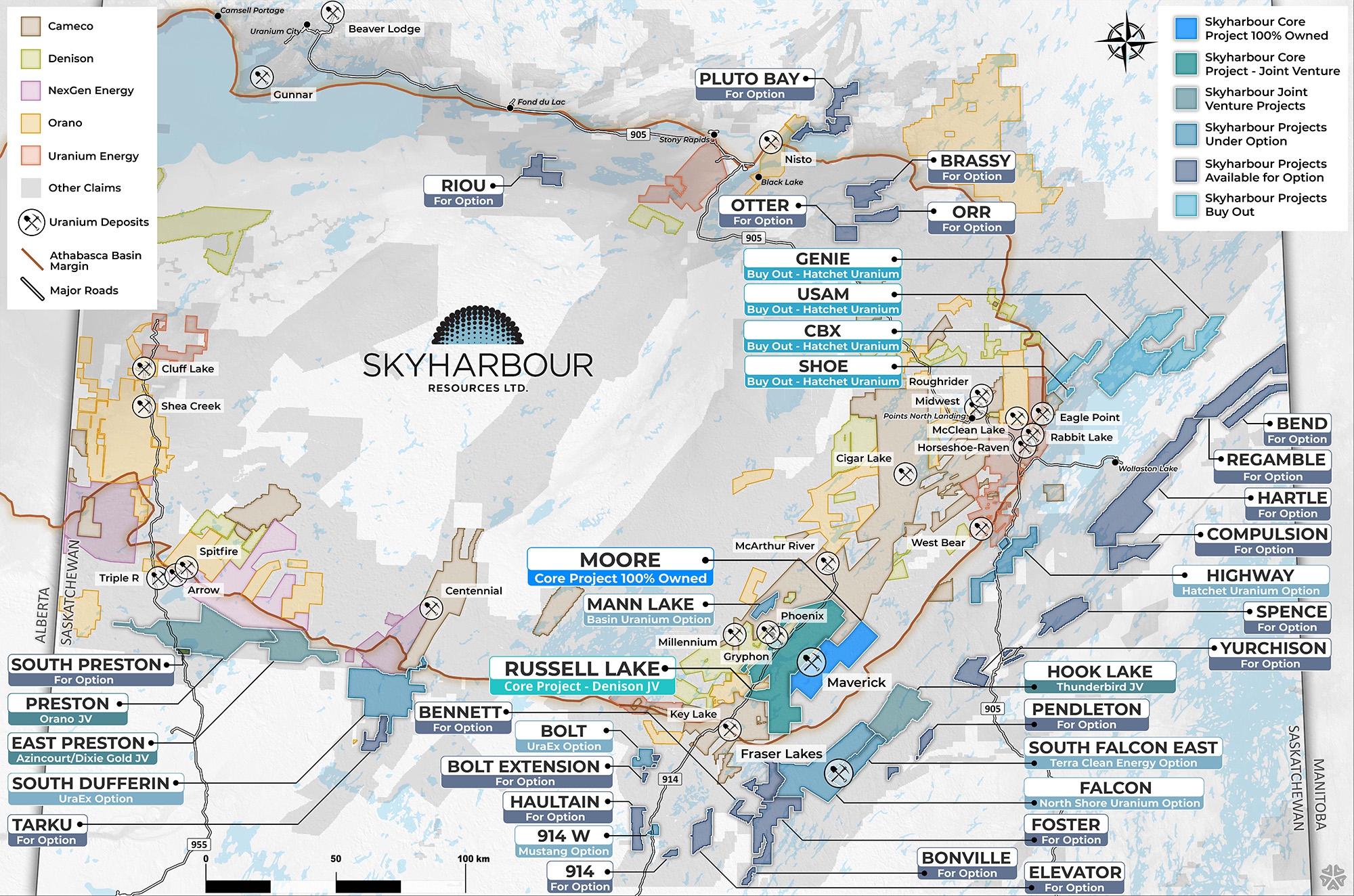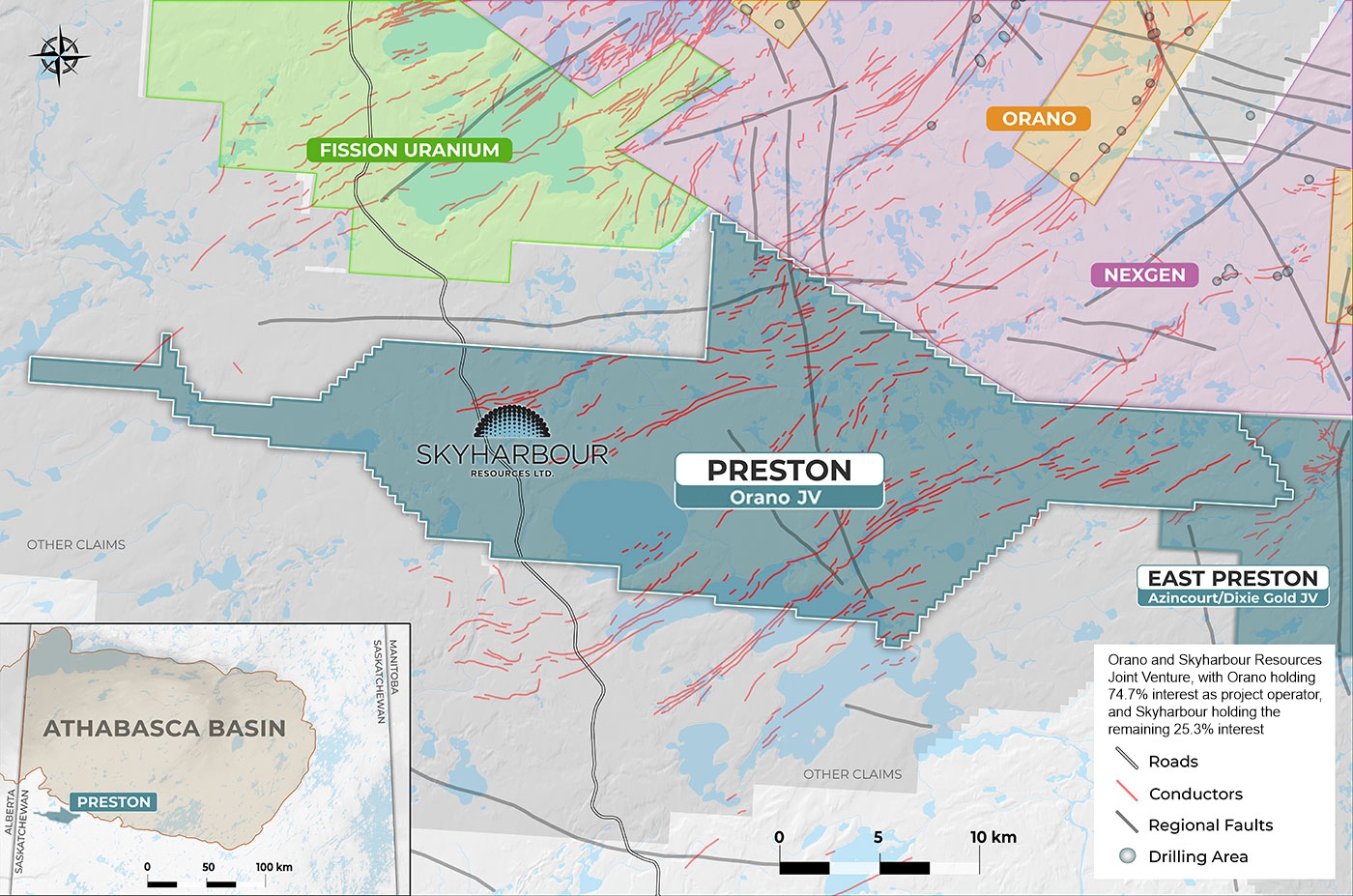View Interactive Map NI 43-101 Technical Report - Preston
Highlights:
- Large 49,635 hectare (122,651 acre) land position strategically located to the south of and adjacent to NexGen Energy's (TSX: NXE) Rook 1 project host to the high grade Arrow deposit, as well as proximal to Fission Uranium’s (TSX: FCU) Patterson Lake South (“PLS”) project host to the high grade Triple R deposit
- The Preston Uranium Property is bisected by the all-weather Highway 955, which runs north through the PLS Project being advanced by Fission through to the former Cluff Lake uranium mine
- March 2017, Skyharbour signed an option agreement with industry-leader and strategic partner Orano (formerly AREVA) Resources Canada to option a majority stake in the Preston Project
- In early 2021, Orano fulfilled their earn-in option interest in the project through funding exploration expenditures and making cash payments. Orano now holds a 74.7% interest in the joint venture and is the operator, with the remaining minority 25.3% interest owned by Skyharbour.
- Historical exploration at the project has consisted of ground gravity, airborne and ground electromagnetics, radon, soil, silt, biogeochem, lake sediment, and geological mapping surveys, as well as several exploratory drill programs
- Numerous high-priority drill target areas associated with multiple prospective exploration corridors have been successfully delineated through this methodical, multiphased exploration initiative, which has culminated in an extensive, proprietary geological database for the project area
- Given the size of the property, exploration to date has only focused on approx. 50% the land package leaving significant exploration upside potential in untested areas
Project Summary:
In March 2017, Skyharbour signed an option agreement with Orano (formerly AREVA Resources Inc.) that provided Orano an earn-in option to acquire a majority working interest in the 49,635 hectare Preston Uranium Project. The significant potential of the Project has been highlighted by past discoveries in the area by NexGen Energy Ltd. (Arrow deposit), Fission Uranium Corp. (Triple R deposit now owned by Paladin Energy), and F3 Uranium Corp. (PLN discovery). Exploration at the Project has consisted of ground gravity, airborne and ground electromagnetics, radon, soil, silt, biogeochem, lake sediment, and geological mapping surveys, as well as exploratory drill programs. Over a dozen high-priority drill target areas associated with multiple prospective exploration corridors have been successfully delineated through these methodical, multi-phased exploration initiatives, which have culminated in an extensive, proprietary geological database for the project area.
2026 Planned Exploration:
The proposed 2026 exploration program at the Preston Uranium Project will consist of a large-scale Airborne Gravity Gradiometry (AGG) survey over the northern portion of the property, followed by detailed ground gravity surveys focused on the highly prospective FSAN and Canoe Lake areas. The geophysical work will refine structural trends and discrete gravity anomalies to advance high-priority drill targeting. A summer drill program of approximately 3,000 to 3,500 metres across about ten helicopter-supported holes is also planned, with the majority of drilling focused on follow-up targets within the FSAN area and additional testing of the underexplored Area B conductive corridor. This integrated program is designed to generate new high-quality targets and further advance the geological model of the Preston Project.
2025 Exploration Program:
The 2025 exploration program at the Preston Uranium Project successfully completed 5,565 metres of helicopter-supported diamond drilling across 17 holes, targeting multiple high-priority zones including Johnson Lake, Canoe Lake, and FSAN. Drilling confirmed the presence of key graphitic shear zones, structurally complex basement settings, and widespread alteration consistent with uranium-fertile systems. The program validated several EM-defined conductors, significantly advanced the geological and structural understanding of the property, and identified multiple priority targets, particularly at Canoe Lake and FSAN, for focused follow-up drilling in 2026.
2024 Field Programs:
The 2024 field program marked the first exploration programs carried out by Orano at Preston since 2020. The completed geophysics covered 35.6 km of ground Moving-Loop Transient ElectroMagnetic (ML-TEM), covering the Preston West target where there is a known conductor, along with the Preston Far West target where a reconnaissance survey was conducted. The ground gravity survey consisted of 2,295 stations and covered an area along the FSAN and FSANE trends.
An SGH soil sampling program with over 1,100 samples commenced in the summer of 2024. The SGH program covered a large area and was a cost-effective, innovative exploration technique used in the Athabasca Basin to vector in on uranium showings associated with certain hydrocarbons.
Joint-Venture with Strategic Partner Orano (formerly AREVA):
Headquartered in Saskatoon, Saskatchewan, Orano Canada Inc. is a leading producer of uranium, accounting for the processing of 18 million pounds of uranium concentrate produced in Canada in 2022. Orano Canada has been exploring for uranium, mining and milling in Canada for more than 55 years. Orano Canada is the operator of the McClean Lake uranium mill and a major partner in the Cigar Lake (40.45%), McArthur River (30.2%) and Key Lake (16.7%) operations. The McClean Lake joint venture is owned by Orano Canada (77.5%) and Denison Mines (22.5%). Orano toll mills the ore from the Cigar Lake mine at the McClean Lake mill.
The company employs about 420 people in Saskatchewan, including about 300 at the McClean Lake operation where over 49% of employees are self-declared Indigenous. As a sustainable uranium producer, Orano Canada is committed to safety, environmental protection and contributing to the prosperity and well-being of neighbouring communities.
Orano Canada Inc. is a 100% subsidiary of Orano Mining, part of the multinational Orano group. As a recognized international operator in the field of nuclear materials, Orano delivers solutions to address present and future global energy and health challenges. Its expertise and mastery of cutting-edge technologies enable Orano to offer its customers high value-added products and services throughout the entire fuel cycle. With uranium mines in operation in Canada, Kazakhstan and Niger, Orano is one of the world’s leading producers of uranium, with competitive production costs and extraction techniques at the cutting edge of innovation. Every day, the Orano group’s 17,000 employees draw on their skills, unwavering dedication to safety and constant quest for innovation, with the commitment to develop know-how in the transformation and control of nuclear materials, for the climate and for a healthy and resource-efficient world, now and tomorrow.
Exploration Programs Conducted by Orano in 2017-2020:
In 2017, Orano completed a Quaternary evaluation and summer fieldwork at Preston, followed by ground EM surveys at Dixon Lake. Later that year, ML-TEM surveys east of Highway 955 outlined conductive trends in the Johnson Lake and Dixon Lake corridors, including anomalies near Canoe Lake and conductors in the FS target area.
Follow-up work included geophysical surveys and historical drilling at FS, which confirmed graphitic conductors. Preparations for additional ML-TEM surveys on JL and FS grids were carried out, with notable silicification and shear features observed on outcrop.
Winter drill programs in 2018 (4,500 m) and 2019 (3,600 m) tested EM-defined targets, intersecting graphitic shear zones, reactivated structures, alteration, and sulfide mineralization consistent with Athabasca uranium systems. The property remains underexplored compared to nearby deposits.
In 2020, Orano used DC resistivity geophysics on the JL, Canoe, and B grids to refine EM targets and identify clay alteration and silicification, adding key information for future drill prioritization.
Historical Exploration in the Preston Region:
An initial review of historic exploration data on the Preston Uranium Property has identified a number of potential areas for follow up. One high-priority area has clusters of anomalous uranium in lake sediment samples, anomalous uranium values in rock samples (up to 5.6 ppm U), and the presence of kilometre-scale northeast-southwest trending graphitic faults associated with sulphides and anomalous radioactivity as identified with scintillometers. A review of historic data has also identified a significant uranium in lake sediment anomaly in the western part of the Preston Uranium Property. A sample collected by the Geological Survey of Canada returned a value of 4.8 ppm U, considered to be significant in an area with a background uranium value of 1 ppm U. This high uranium value may indicate either the down-ice glacial transport of uranium boulders from source or an in-situ source of uranium. For comparison, the highest value down-ice from the Patterson Lake South discovery is 3.8 ppm U. Management cautions that past results or discoveries on proximate land are not necessarily indicative of the results that may be achieved on these properties.
Uranium mineralization in the Patterson Lake area bears a number of similarities to the high-grade uranium deposits in the Eastern part of the Athabasca Basin like those at the Cigar Lake and McArthur River mines. The mineralization occurs in structurally disrupted and strongly clay altered, commonly graphitic pelites and metapelites with narrow felsic segregations / pegmatites. Intervals of quartz-feldspar gneiss and semipelite are also present. Sulphides are commonly associated with the mineralization along with anomalous levels of cobalt, nickel, molybdenum and boron. Uranium mineralization in the Patterson Lake area is also associated with felsic intrusives, primarily pegmatites. Skyharbour has both target types on its pre-existing properties and its recently acquired land in the Patterson Lake region.
Skyharbour and Western Athabasca Syndicate's Exploration Programs 2014-2015



